Function of the US President and the US Congress: Power Evolution
VerifiedAdded on 2023/04/23
|8
|1462
|142
Report
AI Summary
This report analyzes the functions and powers of the United States Congress and the President, exploring the historical evolution of their roles and responsibilities. It highlights the structure of Congress, the differences between the House of Representatives and the Senate, and the checks and balances system designed to prevent any single branch from dominating. The report also discusses the evolving power of the President, particularly in recent times, and provides examples of instances where presidential actions have been met with congressional disapproval. The process by which bills become laws is outlined, emphasizing the importance of collaboration between the legislative and executive branches. The report concludes by advocating for harmonious cooperation between the branches to promote the well-being of the American population. Desklib offers this and many other solved assignments for students.
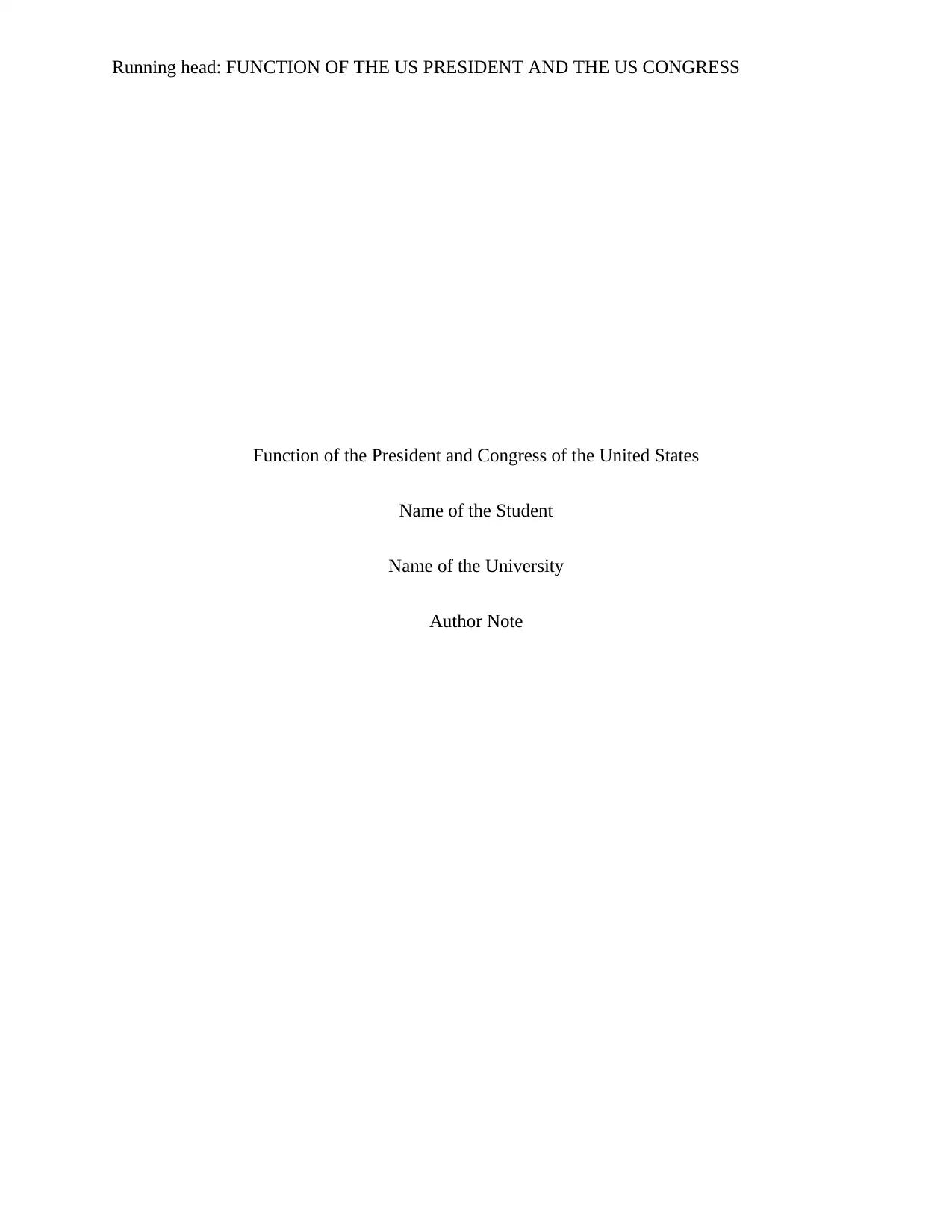
Running head: FUNCTION OF THE US PRESIDENT AND THE US CONGRESS
Function of the President and Congress of the United States
Name of the Student
Name of the University
Author Note
Function of the President and Congress of the United States
Name of the Student
Name of the University
Author Note
Paraphrase This Document
Need a fresh take? Get an instant paraphrase of this document with our AI Paraphraser
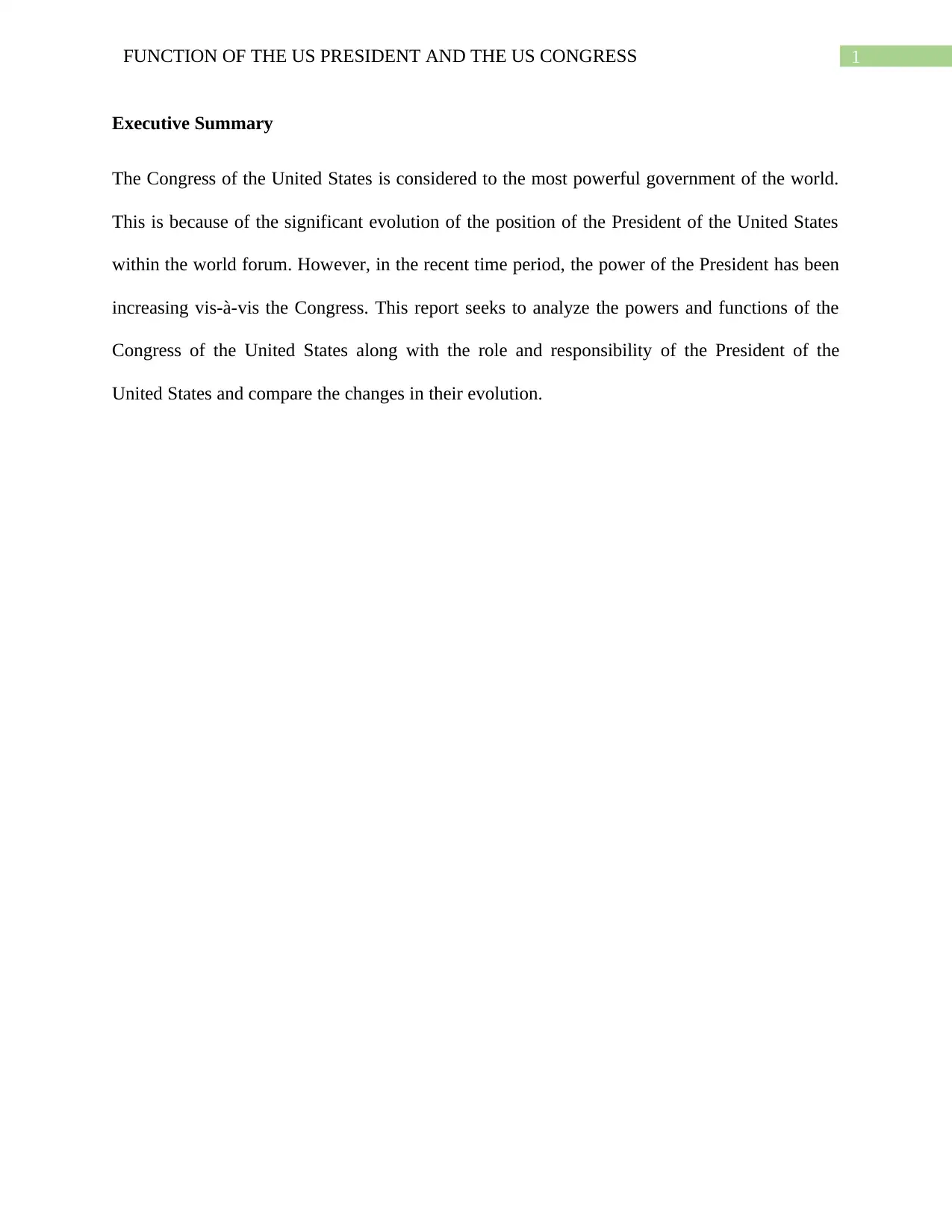
1FUNCTION OF THE US PRESIDENT AND THE US CONGRESS
Executive Summary
The Congress of the United States is considered to the most powerful government of the world.
This is because of the significant evolution of the position of the President of the United States
within the world forum. However, in the recent time period, the power of the President has been
increasing vis-à-vis the Congress. This report seeks to analyze the powers and functions of the
Congress of the United States along with the role and responsibility of the President of the
United States and compare the changes in their evolution.
Executive Summary
The Congress of the United States is considered to the most powerful government of the world.
This is because of the significant evolution of the position of the President of the United States
within the world forum. However, in the recent time period, the power of the President has been
increasing vis-à-vis the Congress. This report seeks to analyze the powers and functions of the
Congress of the United States along with the role and responsibility of the President of the
United States and compare the changes in their evolution.
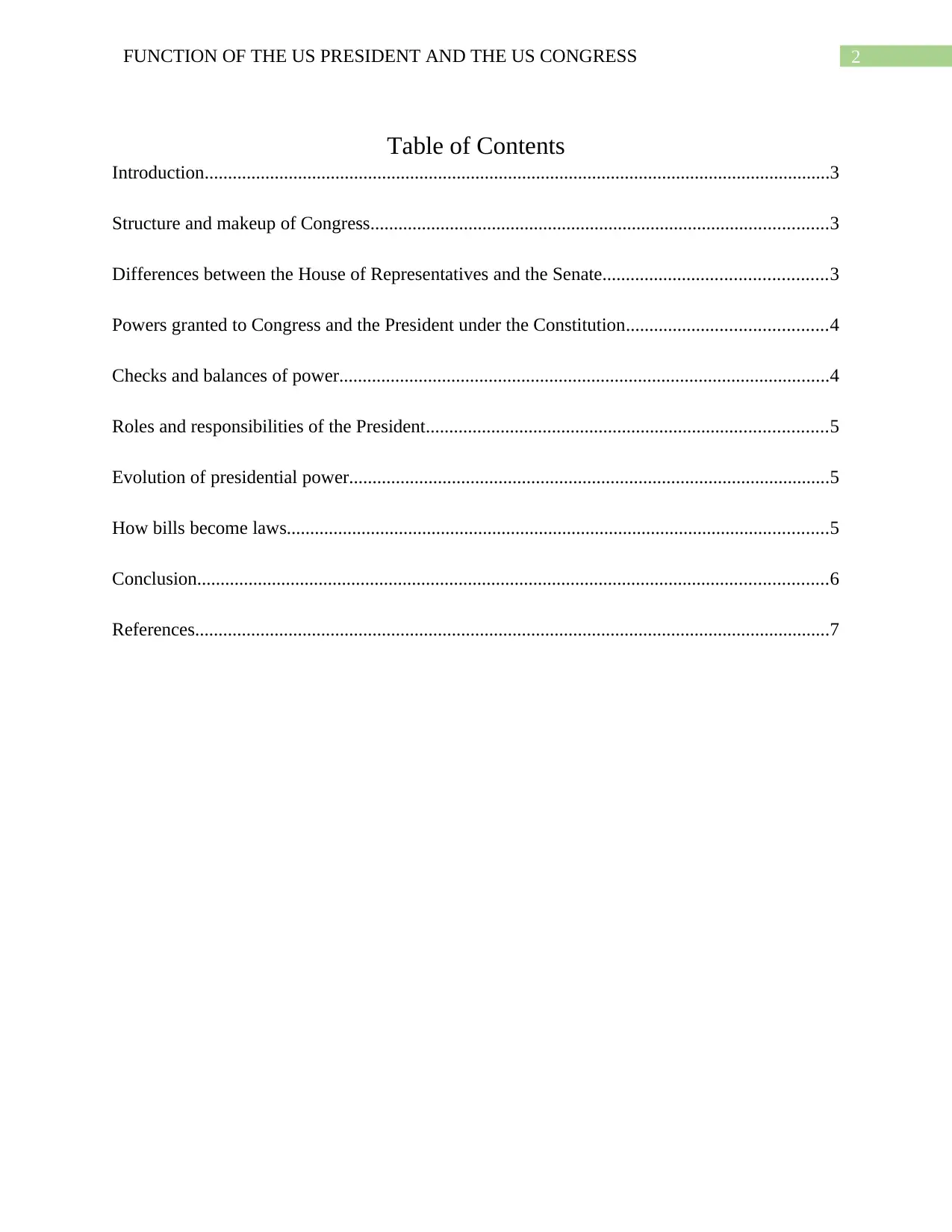
2FUNCTION OF THE US PRESIDENT AND THE US CONGRESS
Table of Contents
Introduction......................................................................................................................................3
Structure and makeup of Congress..................................................................................................3
Differences between the House of Representatives and the Senate................................................3
Powers granted to Congress and the President under the Constitution...........................................4
Checks and balances of power.........................................................................................................4
Roles and responsibilities of the President......................................................................................5
Evolution of presidential power.......................................................................................................5
How bills become laws....................................................................................................................5
Conclusion.......................................................................................................................................6
References........................................................................................................................................7
Table of Contents
Introduction......................................................................................................................................3
Structure and makeup of Congress..................................................................................................3
Differences between the House of Representatives and the Senate................................................3
Powers granted to Congress and the President under the Constitution...........................................4
Checks and balances of power.........................................................................................................4
Roles and responsibilities of the President......................................................................................5
Evolution of presidential power.......................................................................................................5
How bills become laws....................................................................................................................5
Conclusion.......................................................................................................................................6
References........................................................................................................................................7
⊘ This is a preview!⊘
Do you want full access?
Subscribe today to unlock all pages.

Trusted by 1+ million students worldwide
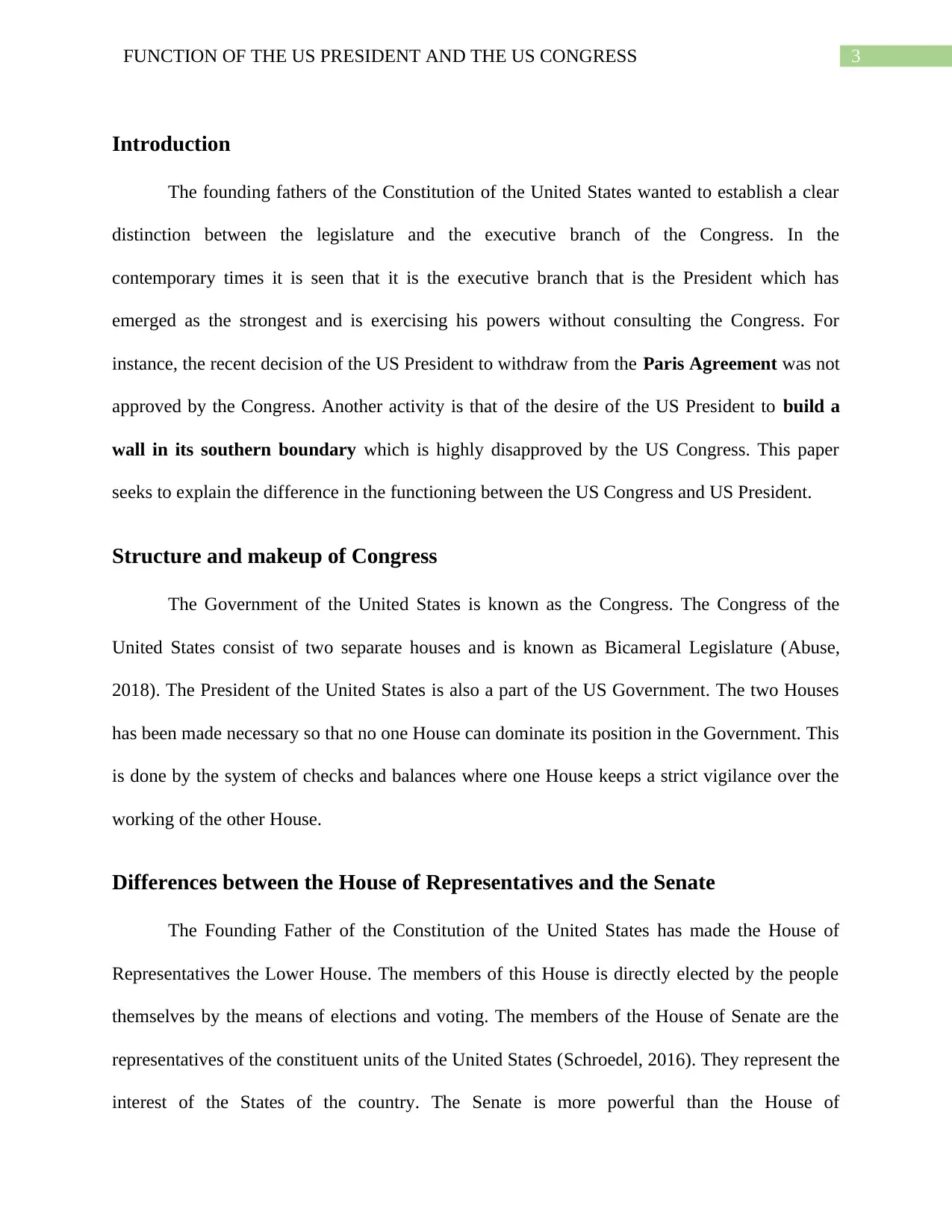
3FUNCTION OF THE US PRESIDENT AND THE US CONGRESS
Introduction
The founding fathers of the Constitution of the United States wanted to establish a clear
distinction between the legislature and the executive branch of the Congress. In the
contemporary times it is seen that it is the executive branch that is the President which has
emerged as the strongest and is exercising his powers without consulting the Congress. For
instance, the recent decision of the US President to withdraw from the Paris Agreement was not
approved by the Congress. Another activity is that of the desire of the US President to build a
wall in its southern boundary which is highly disapproved by the US Congress. This paper
seeks to explain the difference in the functioning between the US Congress and US President.
Structure and makeup of Congress
The Government of the United States is known as the Congress. The Congress of the
United States consist of two separate houses and is known as Bicameral Legislature (Abuse,
2018). The President of the United States is also a part of the US Government. The two Houses
has been made necessary so that no one House can dominate its position in the Government. This
is done by the system of checks and balances where one House keeps a strict vigilance over the
working of the other House.
Differences between the House of Representatives and the Senate
The Founding Father of the Constitution of the United States has made the House of
Representatives the Lower House. The members of this House is directly elected by the people
themselves by the means of elections and voting. The members of the House of Senate are the
representatives of the constituent units of the United States (Schroedel, 2016). They represent the
interest of the States of the country. The Senate is more powerful than the House of
Introduction
The founding fathers of the Constitution of the United States wanted to establish a clear
distinction between the legislature and the executive branch of the Congress. In the
contemporary times it is seen that it is the executive branch that is the President which has
emerged as the strongest and is exercising his powers without consulting the Congress. For
instance, the recent decision of the US President to withdraw from the Paris Agreement was not
approved by the Congress. Another activity is that of the desire of the US President to build a
wall in its southern boundary which is highly disapproved by the US Congress. This paper
seeks to explain the difference in the functioning between the US Congress and US President.
Structure and makeup of Congress
The Government of the United States is known as the Congress. The Congress of the
United States consist of two separate houses and is known as Bicameral Legislature (Abuse,
2018). The President of the United States is also a part of the US Government. The two Houses
has been made necessary so that no one House can dominate its position in the Government. This
is done by the system of checks and balances where one House keeps a strict vigilance over the
working of the other House.
Differences between the House of Representatives and the Senate
The Founding Father of the Constitution of the United States has made the House of
Representatives the Lower House. The members of this House is directly elected by the people
themselves by the means of elections and voting. The members of the House of Senate are the
representatives of the constituent units of the United States (Schroedel, 2016). They represent the
interest of the States of the country. The Senate is more powerful than the House of
Paraphrase This Document
Need a fresh take? Get an instant paraphrase of this document with our AI Paraphraser
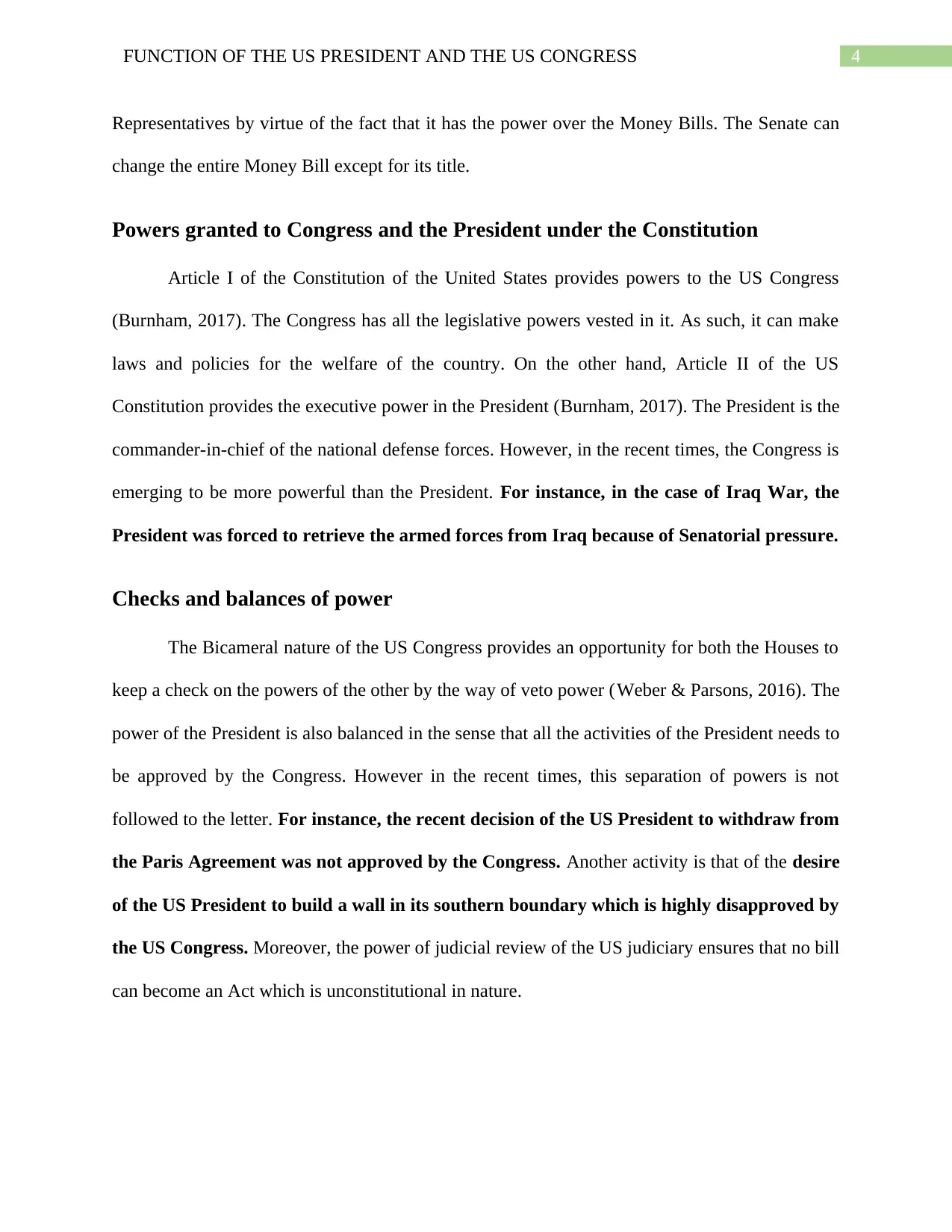
4FUNCTION OF THE US PRESIDENT AND THE US CONGRESS
Representatives by virtue of the fact that it has the power over the Money Bills. The Senate can
change the entire Money Bill except for its title.
Powers granted to Congress and the President under the Constitution
Article I of the Constitution of the United States provides powers to the US Congress
(Burnham, 2017). The Congress has all the legislative powers vested in it. As such, it can make
laws and policies for the welfare of the country. On the other hand, Article II of the US
Constitution provides the executive power in the President (Burnham, 2017). The President is the
commander-in-chief of the national defense forces. However, in the recent times, the Congress is
emerging to be more powerful than the President. For instance, in the case of Iraq War, the
President was forced to retrieve the armed forces from Iraq because of Senatorial pressure.
Checks and balances of power
The Bicameral nature of the US Congress provides an opportunity for both the Houses to
keep a check on the powers of the other by the way of veto power (Weber & Parsons, 2016). The
power of the President is also balanced in the sense that all the activities of the President needs to
be approved by the Congress. However in the recent times, this separation of powers is not
followed to the letter. For instance, the recent decision of the US President to withdraw from
the Paris Agreement was not approved by the Congress. Another activity is that of the desire
of the US President to build a wall in its southern boundary which is highly disapproved by
the US Congress. Moreover, the power of judicial review of the US judiciary ensures that no bill
can become an Act which is unconstitutional in nature.
Representatives by virtue of the fact that it has the power over the Money Bills. The Senate can
change the entire Money Bill except for its title.
Powers granted to Congress and the President under the Constitution
Article I of the Constitution of the United States provides powers to the US Congress
(Burnham, 2017). The Congress has all the legislative powers vested in it. As such, it can make
laws and policies for the welfare of the country. On the other hand, Article II of the US
Constitution provides the executive power in the President (Burnham, 2017). The President is the
commander-in-chief of the national defense forces. However, in the recent times, the Congress is
emerging to be more powerful than the President. For instance, in the case of Iraq War, the
President was forced to retrieve the armed forces from Iraq because of Senatorial pressure.
Checks and balances of power
The Bicameral nature of the US Congress provides an opportunity for both the Houses to
keep a check on the powers of the other by the way of veto power (Weber & Parsons, 2016). The
power of the President is also balanced in the sense that all the activities of the President needs to
be approved by the Congress. However in the recent times, this separation of powers is not
followed to the letter. For instance, the recent decision of the US President to withdraw from
the Paris Agreement was not approved by the Congress. Another activity is that of the desire
of the US President to build a wall in its southern boundary which is highly disapproved by
the US Congress. Moreover, the power of judicial review of the US judiciary ensures that no bill
can become an Act which is unconstitutional in nature.
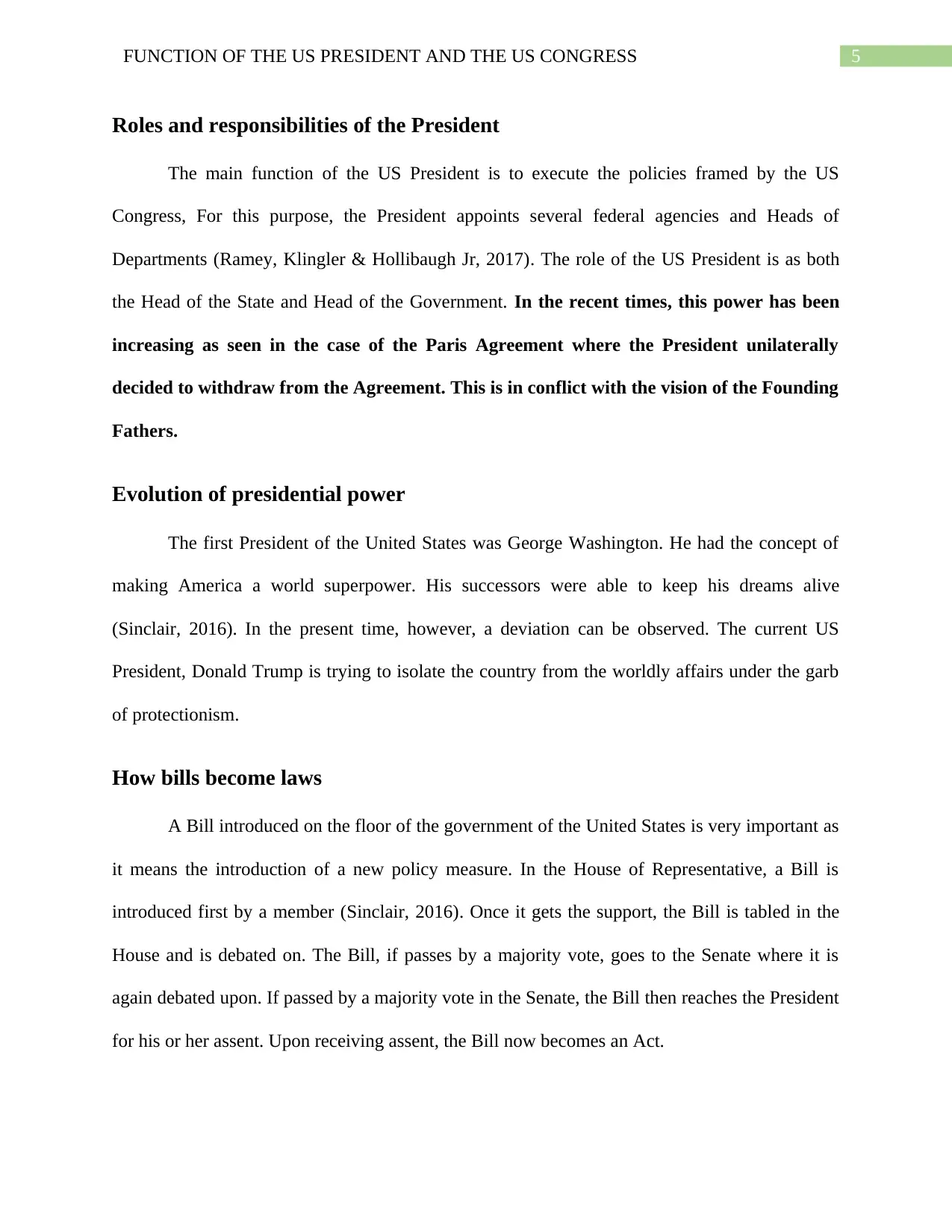
5FUNCTION OF THE US PRESIDENT AND THE US CONGRESS
Roles and responsibilities of the President
The main function of the US President is to execute the policies framed by the US
Congress, For this purpose, the President appoints several federal agencies and Heads of
Departments (Ramey, Klingler & Hollibaugh Jr, 2017). The role of the US President is as both
the Head of the State and Head of the Government. In the recent times, this power has been
increasing as seen in the case of the Paris Agreement where the President unilaterally
decided to withdraw from the Agreement. This is in conflict with the vision of the Founding
Fathers.
Evolution of presidential power
The first President of the United States was George Washington. He had the concept of
making America a world superpower. His successors were able to keep his dreams alive
(Sinclair, 2016). In the present time, however, a deviation can be observed. The current US
President, Donald Trump is trying to isolate the country from the worldly affairs under the garb
of protectionism.
How bills become laws
A Bill introduced on the floor of the government of the United States is very important as
it means the introduction of a new policy measure. In the House of Representative, a Bill is
introduced first by a member (Sinclair, 2016). Once it gets the support, the Bill is tabled in the
House and is debated on. The Bill, if passes by a majority vote, goes to the Senate where it is
again debated upon. If passed by a majority vote in the Senate, the Bill then reaches the President
for his or her assent. Upon receiving assent, the Bill now becomes an Act.
Roles and responsibilities of the President
The main function of the US President is to execute the policies framed by the US
Congress, For this purpose, the President appoints several federal agencies and Heads of
Departments (Ramey, Klingler & Hollibaugh Jr, 2017). The role of the US President is as both
the Head of the State and Head of the Government. In the recent times, this power has been
increasing as seen in the case of the Paris Agreement where the President unilaterally
decided to withdraw from the Agreement. This is in conflict with the vision of the Founding
Fathers.
Evolution of presidential power
The first President of the United States was George Washington. He had the concept of
making America a world superpower. His successors were able to keep his dreams alive
(Sinclair, 2016). In the present time, however, a deviation can be observed. The current US
President, Donald Trump is trying to isolate the country from the worldly affairs under the garb
of protectionism.
How bills become laws
A Bill introduced on the floor of the government of the United States is very important as
it means the introduction of a new policy measure. In the House of Representative, a Bill is
introduced first by a member (Sinclair, 2016). Once it gets the support, the Bill is tabled in the
House and is debated on. The Bill, if passes by a majority vote, goes to the Senate where it is
again debated upon. If passed by a majority vote in the Senate, the Bill then reaches the President
for his or her assent. Upon receiving assent, the Bill now becomes an Act.
⊘ This is a preview!⊘
Do you want full access?
Subscribe today to unlock all pages.

Trusted by 1+ million students worldwide
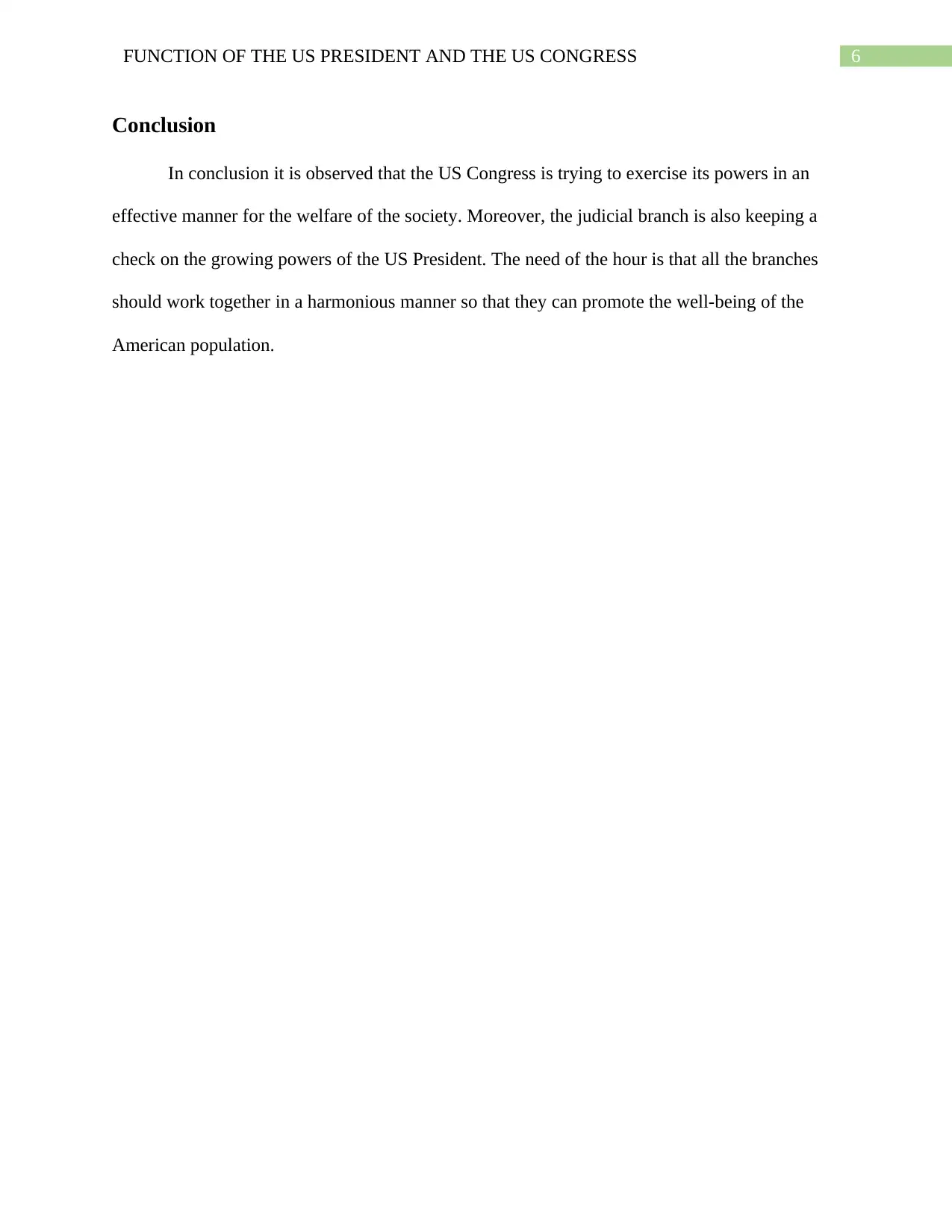
6FUNCTION OF THE US PRESIDENT AND THE US CONGRESS
Conclusion
In conclusion it is observed that the US Congress is trying to exercise its powers in an
effective manner for the welfare of the society. Moreover, the judicial branch is also keeping a
check on the growing powers of the US President. The need of the hour is that all the branches
should work together in a harmonious manner so that they can promote the well-being of the
American population.
Conclusion
In conclusion it is observed that the US Congress is trying to exercise its powers in an
effective manner for the welfare of the society. Moreover, the judicial branch is also keeping a
check on the growing powers of the US President. The need of the hour is that all the branches
should work together in a harmonious manner so that they can promote the well-being of the
American population.
Paraphrase This Document
Need a fresh take? Get an instant paraphrase of this document with our AI Paraphraser
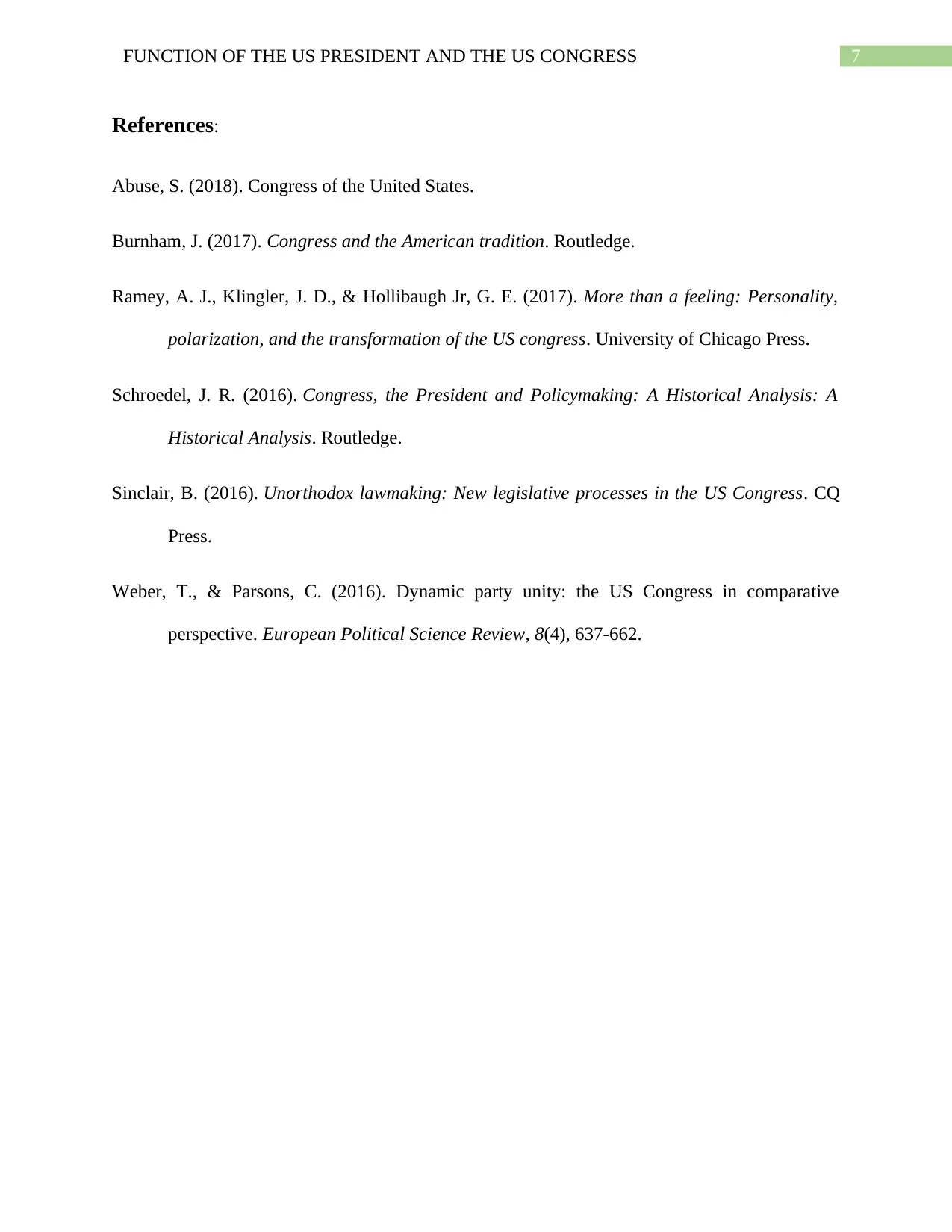
7FUNCTION OF THE US PRESIDENT AND THE US CONGRESS
References:
Abuse, S. (2018). Congress of the United States.
Burnham, J. (2017). Congress and the American tradition. Routledge.
Ramey, A. J., Klingler, J. D., & Hollibaugh Jr, G. E. (2017). More than a feeling: Personality,
polarization, and the transformation of the US congress. University of Chicago Press.
Schroedel, J. R. (2016). Congress, the President and Policymaking: A Historical Analysis: A
Historical Analysis. Routledge.
Sinclair, B. (2016). Unorthodox lawmaking: New legislative processes in the US Congress. CQ
Press.
Weber, T., & Parsons, C. (2016). Dynamic party unity: the US Congress in comparative
perspective. European Political Science Review, 8(4), 637-662.
References:
Abuse, S. (2018). Congress of the United States.
Burnham, J. (2017). Congress and the American tradition. Routledge.
Ramey, A. J., Klingler, J. D., & Hollibaugh Jr, G. E. (2017). More than a feeling: Personality,
polarization, and the transformation of the US congress. University of Chicago Press.
Schroedel, J. R. (2016). Congress, the President and Policymaking: A Historical Analysis: A
Historical Analysis. Routledge.
Sinclair, B. (2016). Unorthodox lawmaking: New legislative processes in the US Congress. CQ
Press.
Weber, T., & Parsons, C. (2016). Dynamic party unity: the US Congress in comparative
perspective. European Political Science Review, 8(4), 637-662.
1 out of 8
Related Documents
Your All-in-One AI-Powered Toolkit for Academic Success.
+13062052269
info@desklib.com
Available 24*7 on WhatsApp / Email
![[object Object]](/_next/static/media/star-bottom.7253800d.svg)
Unlock your academic potential
Copyright © 2020–2025 A2Z Services. All Rights Reserved. Developed and managed by ZUCOL.





